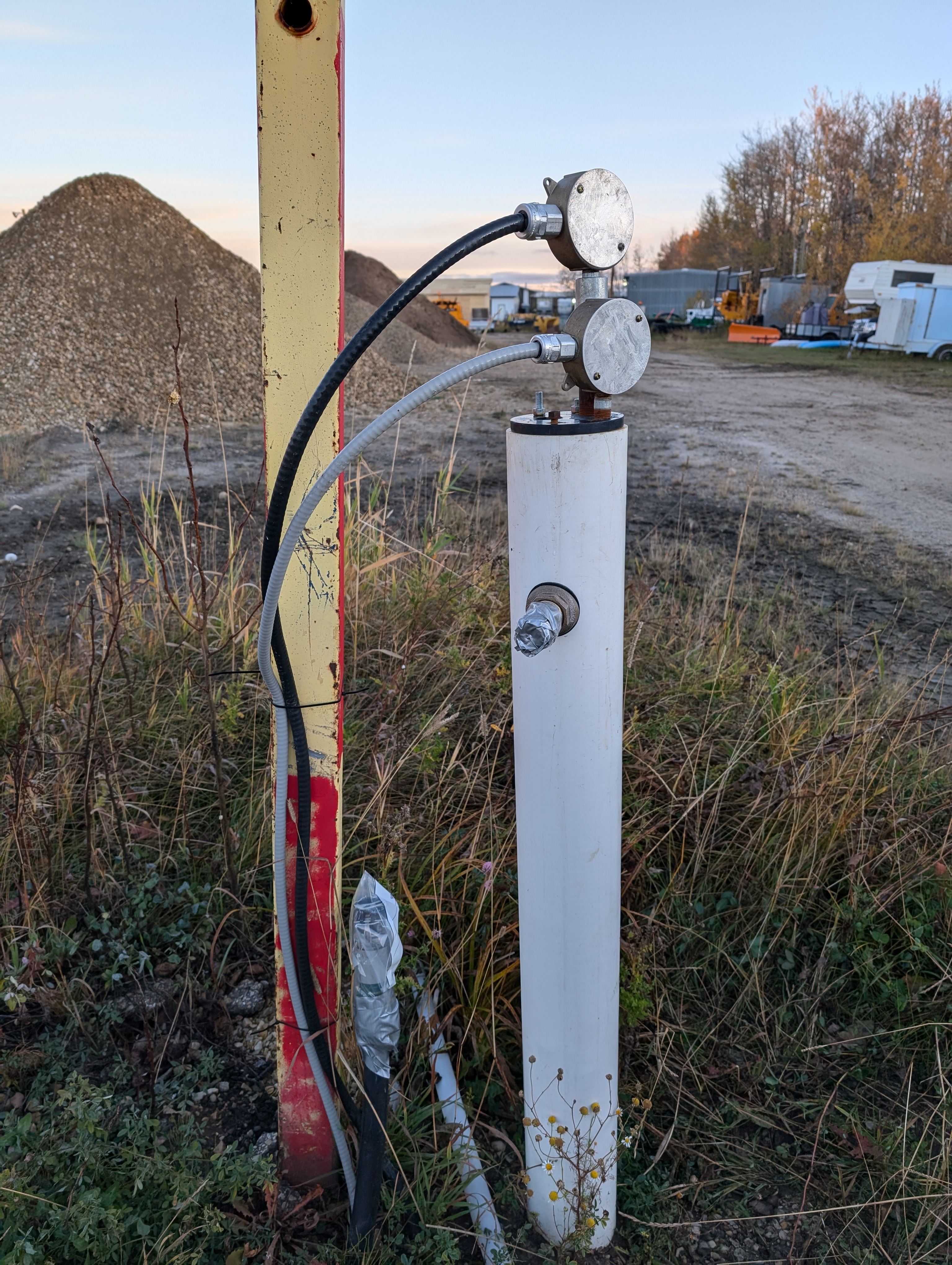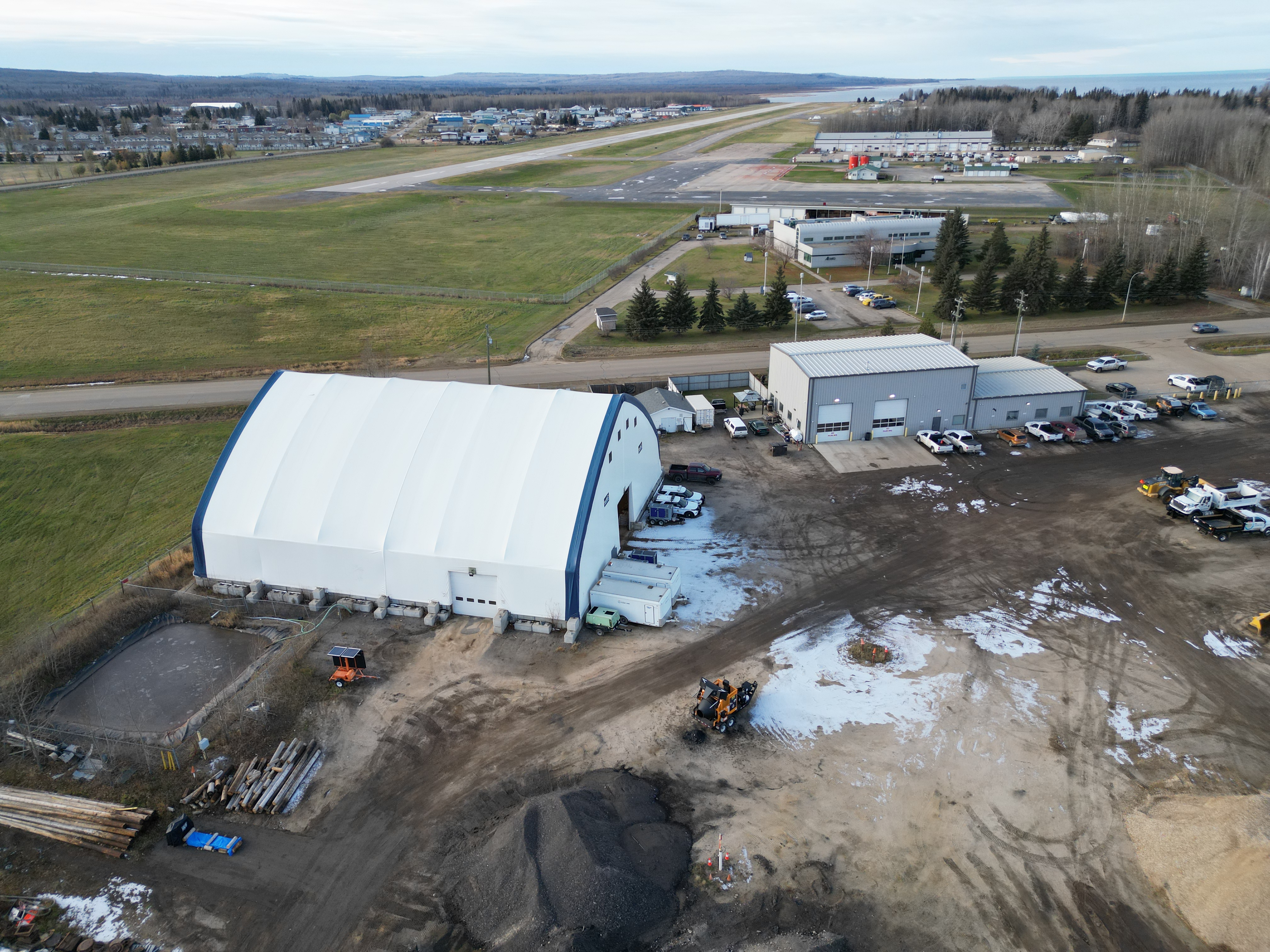Containing the contaminant while not impacting operations.
Salt contamination can enter the soil and groundwater, impact vegetation, and have adverse effects on the environment. Public works yards and highway maintenance yards in Alberta historically stored road salts and sand (mixtures known as pickled sand) directly on the gravel yard surface. Today, management and storage of road salt and sand has improved, but the impacts of historically improper storage continue to impact our environment.
As the effects of improperly stored pickled sand became known in communities across Alberta, regulators required these facilities to improve their salt storage and management practices and develop plans to assess, manage, and remediate the environmental contamination, with support from environmental consultants.
The Town of Slave Lake (TOSL) has been operating its current Public Works Yard since 1994. In addition to providing a base for the town’s operation and maintenance services, it houses and manages the town’s pickled sand that is used each winter. In the beginning, the pickled sand was stored and handled directly on the gravel yard surface. Wind would blow it into the surrounding areas, and rain and snow melt would cause it to infiltrate the soil and get into the soil and groundwater. As soil and groundwater contamination related to salt storage facilities became known, TOSL engaged a consultant to conduct environmental site assessments (ESAs) between 2004 and 2009. Following those ESAs, Alberta Environment and Protected Areas (EPA) recommended additional assessments and the development of an environmental risk management plan (RMP). Thurber Engineering Ltd. (Thurber) began working with TOSL in 2012 as their environmental engineering consultant, and we remain TOSL’s environmental consultant today.
Thurber initially conducted a Phase III Environmental Site Assessment (ESA) to vertically and laterally characterize and delineate the extents of salt impacts on the surrounding area including on the Sawridge First Nation Lands to the east of the site, and toward Lesser Slave Lake – located about one kilometer west of the site. Thurber’s preliminary work included a comprehensive investigation of the subsurface soil and groundwater. We completed:
- a vertical terrain conductivity profile at each borehole to evaluate the soil conductivity behaviour with depth
- geophysics surveys of the areal footprint of the areal footprint of the salinity plume
- evaluation of the salinity concentrations in the soil and groundwater in various hydrogeological units
Since higher electrical conductivity correlated to salt concentrations in soil and groundwater, Thurber used the results of the investigation to develop a conceptual site model that delineated the salt contamination on the site and the extent of contamination in various areas off-site.
Once we understood the extent of the contamination, we developed a Preliminary RMP in collaboration with AEP, TOSL, and the Sawridge First Nation. The RMP proposed:
- shallow soil remediation to address the elevated sodium adsorption ratio levels offsite
- a groundwater remediation program to reduce the chloride mass in the soil and groundwater beneath the site
- a groundwater monitoring program
Our innovative solutions
How do you remediate a site while it is still active as a contaminant storage and handling area? The impacted area was originally estimated to be 11,000 m2 resulting in a total impacted soil volume of approximately 60,000 m3 to 80,000 m3 . The simplest option would have been to excavate the contaminated soil and transport it to a landfill for disposal. This is, however, not a sustainable solution as the soil simply gets moved and not treated. It would also require that clean fill be brought in to replace the soil and would have disrupted the active operations onsite. Further, the cost for dig-and-dump at the time would have been nearly $8 million. Thurber’s solution has, to date, cost TOSL approximately $500K and has removed contaminants rather than relocating them.
Containing the contaminant. TOSL is commited to continuous improvement and due diligence. In 2004, TOSL constructed an asphalt storage pad for the pickled sand to prevent infiltration of brine leachate into the ground. Thurber continued to provide guidance to improve environmental management practices at the site and in 2016, a TOSL constructed a quonset over the pad to prevent rain and snow from generating runoff and to stop the wind from blowing the pickled sand off-site.

Using existing infrastructure. To begin remediating the site, Thurber made use of the existing onsite infrastructure including power, equipment, and water retention pond. Using large-diameter recovery wells and trenches, Thurber designed and fabricated a groundwater recovery system that collected impacted groundwater from the salinity plume and pumped it to the onsite retention pond. The water was regularly trucked out for treatment in the town’s wastewater treatment facility. This system has been in operation since 2015 and to date, has removed over 1,100 m3 of salt impacted water and approximately 8,500 kg of chloride from the site.

No impact to operations. The groundwater recovery system has been effective at the site, but the true innovation was that Thurber actively remediated a contaminated site without disrupting ongoing operations. With all cables and piping for the remediation run underground, the town’s operations and maintenance activities continued on the surface while remediation of the salinity impacts was actively occurring below ground. Further, workers at the town yard were supportive of the remediation efforts thanks to Thurber’s ongoing communication and collaboration with TOSL.
Soil stabilization. During our assessments, we observed that the vegetation growth east of the site, on the Sawridge Nation’s lands, was hindered. Investigation of the shallow soils and groundwater identified that the sodium absorption ratio (SAR) level was elevated and impacting the vegetation. To address this, we conducted a seasonal application of gypsum to stabilize the soil, flush out sodium, and improve the soil chemistry and structure.
A success for the town of Slave Lake
Thurber continues to evaluate the effectiveness of our approach by conducting periodic geophysics surveys understand how the contaminant plume is evolving. To date, we have seen the contaminant plume area decrease by over 50% since the initial assessments.
Thank you to the Town of Slave Lake for this exciting opportunity. We're pleased to be helping decrease contamination on this site.


